
easy full1
.doc-
A body is moving parallel to the z-axes. Its velocity is constant and equal to 12 m/s. Which vector of velocity is possible:
-

-
No correct answer
-
The velocity of the body is
 . What is the position vector for this body (in general form)?
. What is the position vector for this body (in general form)?
-
No correct answer
-
Velocity of a body depends on time by the following form
 .
What is the unit of the coefficient [B]?
.
What is the unit of the coefficient [B]?
-
No correct answer
-
The SI unit of density is?
-
[kg/m3]
-
[kg/cm3]
-
[g/m3]
-
[1/m3]
-
No correct answer
-
Every action or force upon an object must have an equal and ____________ reaction.
-
Measurable
-
Complete
-
Opposite
-
Correct
-
No correct answer
-
A baseball of mass m is thrown upward with some initial speed. A gravitational force is exerted on the ball
-
At all points in its motion
-
At all points in its motion except at the highest point
-
At no points in its motion
-
Only at downward part of its direction
-
No correct answer
-
The kinetic friction will always be
-
Greater than static friction
-
Equal to the static friction
-
Less than static friction
-
Negative
-
No correct answer
-
The unit of coefficient of friction in SI system is
-
Newton
-
Dyne
-
None of these
-
No unit
-
No correct answer
-
Whenever a constant force is applied on a body then it will move with __________.
-
Constant Speed
-
Constant Velocity
-
Constant Acceleration
-
None of them
-
No correct answer
-
Power is a __________.
-
Scalar Quantity
-
Vector Quantity
-
None of these
-
Rate of force
-
No correct answer
-
The dot product of force and velocity is called __________.
-
Work
-
Power
-
Energy
-
Momentum
-
impulse
-
When the force and displacement are perpendicular to each other, then work is __________.
-
zero
-
Maximum
-
None of these
-
Depends on force magnitude
-
No correct answer
-
Centripetal acceleration and tangential acceleration are always __________.
-
Parallel to Each other, but in opposite direction
-
Perpendicular to each other
-
None of these
-
Parallel to each other, but in the same direction
-
Equal to each other
-
The dimensions of angular momentum are __________.
-
MLT-1
-
MLT-3
-
MLT-2
-
ML2T-2
-
ML2T-1
-
The moment of inertia of a wheel about its axle does not depend upon its:
-
Diameter
-
Mass
-
distribution of mass
-
speed of rotation
-
radius
-
Two waves have the same frequency. Which wave characteristic must also be identical for both waves?
-
Phase
-
Amplitude
-
All charateristics
-
Intensity
-
Period
-
A mechanical wave generally does NOT
-
move the medium from one place to another
-
move through a medium
-
move through solids
-
disturb the medium
-
have a interference effect
-
The moment of inertia of a body depends on
-
the angular velocity
-
the angular acceleration
-
the mass distribution
-
the torque acting on the body
-
direction of rotation
-
A skater can spin faster by pulling in her arms closer to her body or spin slower by spreading her arms out from her body. This is due to
-
Conservation of momentum
-
Newton’s second law
-
Conservation of energy
-
Newton’s third law
-
Conservation of angular momentum
-
The SI units for Coulomb constant ke are:
-
N·m2/C2
-
N·m/C
-
N·m/C2
-
m2/C2
-
No correct answer
-
The electric field vector E can be expressed as:
-
E=Fe/q
-
E=Fe/q2
-
E=Fe·q
-
E=Fe·q2
-
No correct answer
-
If the electric field is uniform and makes an angle θ with the normal to a surface of area A, the electric flux through the surface is:
-
EAcosθ
-
EAsinθ
-
Acosθsinθ
-
Ecosθ
-
No correct answer
-
Gauss’s law says that the net electric flux through any closed gaussian surface is equal to:
-
qin/ε0
-
qin·ε0
-
ε0/qin
-
qinqout/ε0
-
No correct answer
-
The potential difference between two points A and B in a uniform electric field E, where s (d=|s|) is a vector that points from A to B and is parallel to E is:
-
∆V=-Ed
-
∆V=0
-
∆V=Ed
-
∆V=-Edsinθ
-
No correct answer
-
The SI unit of capacitance is:
-
C/V
-
V/C
-
C/V2
-
C/V·m
-
No correct answer
-
The equivalent capacitance of a parallel combination of capacitors is:
-
Ceq=C1+C2+C3+...
-
1/Ceq=1/C1+1/C2+1/C3+...
-
Ceq=C1=C2=C3=...
-
Ceq=C1·C2·C3·...
-
No correct answer
-
If two or more capacitors are connected in series, the equivalent capacitance of the series combination is given by:
-
Ceq=C1+C2+C3+...
-
1/Ceq=1/C1+1/C2+1/C3+...
-
Ceq=C1=C2=C3=...
-
Ceq=C1·C2·C3·...
-
No correct answer
-
The average current in a conductor is related to the motion of the charge carriers through the relationship:
-
Iav=nqvdA
-
Iav=nqvd
-
Iav=qvdA
-
Iav=nq/vdA
-
No correct answer
-
Ohm’s law in the differential form is:
-
J=σE
-
I=U/R
-
I=R/U
-
J=σ/E
-
No correct answer
-
Ohm’s law in the integral form is:
-
J=σE
-
I=U/R
-
I=R/U
-
J=σ/E
-
No correct answer
-
For a uniform block of material of cross sectional area A and length l, the resistance over the length l is:
-
R=ρl/A
-
R=l/A
-
R=A/l
-
R=lA
-
No correct answer
-
The power supplied to the element, is:
-
P=I∆V
-
P=I/∆V
-
P=I2∆V
-
P=I∆V2
-
No correct answer
-
The power delivered to a resistor can be defined as:
-
P=I2R
-
P=IR
-
P=IR2
-
P=I2/R
-
No correct answer
-
The equivalent resistance of a set of resistors connected in series is:
-
Req=R1+R2+R3+...
-
1/Req=1/R1+1/R2+1/R3+...
-
Req=1/(R1+R2+R3+...)
-
Req=R1+R2+R3+...
-
No correct answer
-
The equivalent resistance of a set of resistors connected in parallel is found from the relationship:
-
Req=R1+R2+R3+...
-
1/Req=1/R1+1/R2+1/R3+...
-
Req=1/(R1+R2+R3+...)
-
Req=R1+R2+R3+...
-
No correct answer
-
Two objects, with different sizes, masses, and temperatures, are placed in thermal contact. Energy travels
-
From the larger object to the smaller object
-
From the object with more mass to the one with less
-
From the object at higher temperature to the object at lower temperature
-
Energy doesn’t travel
-
From the object at lower temperature to the object at higher temperature
-
On a day when the temperature reaches 50°F, what is the temperature in degrees Celsius and in kelvins?
-
500 C, 323 K,
-
400 C, 313 K,
-
300 C, 303 K,
-
200 C, 293 K,
-
100 C, 283 K.
-
The first law of thermodynamics can be given as ________.
-
for any spontaneous process, the entropy of the universe increases
-
the entropy of a pure crystalline substance at absolute zero is zero
-
ΔS = Q/T at constant temperature
-
ΔE = Q + W
-
if two systems are in thermal equilibrium with a third system, they are also in thermal equilibrium with each other
-
The second law of thermodynamics can be given as __________
-
for any spontaneous process, the entropy of the universe increases
-
the entropy of a pure crystalline substance at absolute zero is zero
-
ΔS = Q/T at constant temperature
-
if two systems are in thermal equilibrium with a third system, they are also in thermal equilibrium with each other
-
ΔE = Q + W
-
Which of the following is not a state function?
-
Pressure
-
Volume
-
Temperature
-
Mole
-
Energy
-
Two containers hold an ideal gas at the same temperature and pressure. Both containers hold the same type of gas but container B has twice the volume of container A. The average translational kinetic energy per molecule in container B is
-
twice that for container A
-
the same as that for container A
-
half that for container A
-
impossible to determine
-
twice or half that for container A, depends on the material containers
-
Two containers hold an ideal gas at the same temperature and pressure. Both containers hold the same type of gas but container B has twice the volume of container A. The internal energy of the gas in container B is
-
twice that for container A
-
the same as that for container A
-
half that for container A
-
twice or half that for container A, depends on the material containers
-
impossible to determine
-
Two containers hold an ideal gas at the same temperature and pressure. Both containers hold the same type of gas but container B has twice the volume of container A. The rms speed of the gas molecules in container B is
-
twice that for container A
-
the same as that for container A
-
half that for container A
-
twice or half that for container A, depends on the material containers
-
impossible to determine
-
How does the internal energy of an ideal gas change as it follows path
 in figure?
in figure?
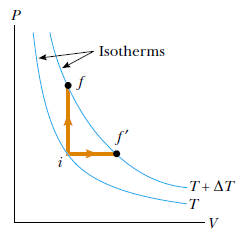
-
 increases
increases
-
 decreases
decreases -
 stays
the same
stays
the same -
There is not enough information to determine how
 changes
changes -
In isothermal process there isn’t internal energy

How
does the internal energy of an ideal gas as it follows path
![]() along the isotherm labeled
along the isotherm labeled
![]() in figure?
in figure?

-
 increases
increases -
 decreases
decreases
-
 stays
the same
stays
the same
-
There is not enough information to determine how
 changes
changes -
In isothermal process there isn’t internal energy

-
Latent heat is
-
the heat released or absorbed by a thermodynamic system during a process that occurs without a change in temperature
-
the amount of energy needed to raise the temperature of sample by 1°C
-
the heat capacity per unit mass
-
the amount of heat required to change a unit mass of a substance by one degree in temperature
-
amount of energy necessary to raise the temperature of 1 g of water from 14.5°C to 15.5°C.
-
Adiabatic process is
-
process that occurs at constant volume
-
process that occurs at constant temperature
-
process that occurs at constant pressure
-
process in which the net heat transfer between the system and its surroundings is zero
-
process that obeys the relation: pVn=C
-
A diatomic gas molecule has ... degrees of freedom
-
3
-
5
-
6
-
7
-
7 and more
-
Energy may be transferred by
-
work
-
conduction
-
convection
-
radiation
-
all answers are correct
-
The molar specific heat of a gas is measured at constant volume and found to be 11R/2. The gas is most likely to be
-
monatomic
-
diatomic
-
monatomic or diatomic, depends on the conditions
-
polyatomic
-
all answers are incorrect
-
Parallel wires carrying currents I1 and I2 respectively
-
repel if they are directed opposite
-
will attract if they are directed opposite
-
will not interact
-
will always repel, no matter which direction they have
-
will always attract, no matter which direction they have
-
What are the opposite ends of a magnet called?
-
Its terminals
-
Its north and south poles
-
Its magnetic fields
-
Its electromagnetic poles
-
Negative and positive poles
-
How are electrical charges and magnetic poles similar?
-
Unlike attract and the same type repel
-
Both are plus and minus
-
Magnetic poles attract electrons
-
Both change positive to negative charges
-
No correct answer
-
How can you show that electricity creates a magnetic field?
-
Use a compass near a wire with current flowing through it
-
Only magnets create magnetic fields
-
Move a wire through a magnetic field
-
Electricity does not create a magnetic field
-
Connect a battery to the magnetic field
-
How can you make an electromagnet?
-
Attach a natural magnet to a battery
-
Run current through a wire wrapped around an iron rod
-
Line up the N and S poles of a magnet with an electric wire
-
Wrap a magnet around a piece of wire with current flowing through it
-
No correct answer
-
What happens when you turn off the current in an electromagnet?
-
The magnetism is turned off
-
The current keeps flowing because of the magnetic force
-
The electromagnet reverses its polarity
-
The electromagnet becomes a generator
-
Nothing happens
-
How can you create electricity with a magnet?
-
Attach a magnet to a battery
-
By putting a current through a wire around a magnet
-
By moving a wire through a magnetic field
-
You can't, because only friction on electric charges creates electricity
-
No correct answer
-
Can you create electricity with a magnet?
-
No, because only friction on electric charges or batteries create electricity
-
Yes, by moving a wire through a magnetic field
-
Yes, by putting a current through a wire around a magnet
-
Yes because magnets use electricity to stay effective
-
It is impossible
-
The geomagnetic field
-
makes the Earth like a huge horseshoe magnet
-
runs exactly through the geographic poles
-
makes a compass work
-
makes an electromagnet work
-
makes all material electromagnet
-
A material that can be permanently magnetized is generally said to be
-
Magnetic
-
dielectric
-
electromagnetic
-
permanently magnetic
-
ferromagnetic
-
The magnetic flux around a straight current-carrying wire
-
gets stronger with increasing distance from the wire
-
is strongest near the wire
-
does not vary in strength with distance from the wire
-
consists of straight lines parallel to the wire
-
depends only on current direction
-
The gauss is a unit of
-
overall magnetic field strength
-
electric field strength
-
ampere-turns
-
magnetic flux density
-
magnetic power
-
If a wire coil has 10 turns and carries 500 mA of current, what is the magnetomotive force in ampere-turns?
-
5,000
-
50
-
0.5
-
5.0
-
0.02
-
Which of the following is not generally observed in a geomagnetic storm?
-
Charged particles streaming out from the Sun
-
All of them is not observed
-
Fluctuations in the Earth’s magnetic field
-
Disruption of electrical power transmission
-
Disruption of microwave propagation
-
A device that reverses magnetic field polarity to keep a dc motor rotating is
-
a solenoid
-
a galvanometer
-
an armature coil
-
a commutator
-
a field coil
-
When the speed at which a conductor is moved through a magnetic field is increased, the induced voltage
-
increases
-
decreases
-
remains constant
-
reaches zero
-
increases and then decreases
-
The induced voltage across a coil with 250 turns that is located in a magnetic field that is changing at a rate of 8 Wb/s is
-
1,000 V
-
2,000 V
-
31.25 V
-
312.5V
-
3.125 V
-
For a given wirewound core, an increase in current through the coil
-
reverses the flux lines
-
decreases the flux density
-
increases the flux density
-
causes no change in flux density
-
decreases the density by factor of 2
-
If the cross-sectional area of a magnetic field increases, but the flux remains the same, the flux density
-
Increases
-
decreases
-
remains the same
-
doubles
-
increases and then decreases
-
When the current through the coil of an electromagnet reverses,
-
direction of the magnetic field reverses
-
direction of the magnetic field remains unchanged
-
magnetic field expands
-
magnetic field collapses
-
magnetic field doubles
-
What is the reluctance of a material that has a length of 0.07 m, a cross-sectional area of 0.014 m2, and a permeability of 4,500
 Wb/At
× m?
Wb/At
× m?
-
1111 At/Wb
-
111 At/Wb
-
11 At/Wb
-
1 At/Wb
-
0.1 At/Wb
-
A coil of wire is placed in a changing magnetic field. If the number of turns in the coil is decreased, the voltage induced across the coil will
-
increase
-
decrease
-
remain constant
-
be excessive
-
increases and then decreases
-
What is the flux density when the flux is 5.5
 Wb
and the cross-sectional area is 6 × 10–3
m2?
Wb
and the cross-sectional area is 6 × 10–3
m2?
-
91.7 µT
-
917 µT
-
91 T
-
9.7 T
-
0.9T
-
If the steel disk in a crankshaft position sensor has stopped with the tab in the magnet's air gap, the induced voltage
-
increases
-
decreases
-
is zero
-
will remain constant
-
increases and then decreases
-
What is the flux density in a magnetic field in which the flux in 0.1 m2 is 600 µWb?
-
6,000 µT
-
600 µT
-
600 T
-
6 T
-
0.6T
-
What is the charge carrier in semiconductors?
-
Holes
-
Electrons
-
Ions
-
Holes and ions
-
Holes and electrons
-
p –type semiconductor means
-
majority charge carrier is electrons
-
majority charge carrier is holes
-
majority charge carrier is ions
-
majority charge carriers are electrons and holes
-
conduct no current at all
-
n –type semiconductor means
-
majority charge carrier is electrons
-
majority charge carrier is holes
-
majority charge carrier is ions
-
majority charge carriers are electrons and holes
-
conduct no current at all
-
Show the SI unit of magnetic field B:
-
T
-
Wb
-
A/m
-
A
-
V
-
Basic source of magnetism ______________.
-
Charged particles alone
-
Movement of charged particles
-
Magnetic dipoles
-
Magnetic and electric domains
-
No correct answer
-
Show the SI unit of magnetic flux:
-
T
-
Wb
-
A/m
-
A
-
V
-
Which of the following statements is correct?
-
Earth's north pole is magnetic north
-
The north pole of a magnet points towards the Earth's north pole.
-
Like poles of a magnet attract each other and unlike poles repel.
-
The SI unit of the magnetic field is the gauss
-
No correct answer
-
Three particles travel through a region of space where the magnetic field is out of the page, as shown in Figure. The electric charge of each of the three particles is, respectively,
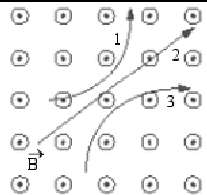
-
1 is neutral, 2 is negative, and 3 is positive
-
1 is negative, 2 is neutral, and 3 is positive
-
1 is positive, 2 is negative, and 3 is neutral
-
1 is positive, 2 is neutral, and 3 is negative
-
No correct answer
-
What is the inductive reactance of a 20-mH inductor at a frequency of 60 Hz?
-
7.5 m

-
0.13

-
7.5

-
12E-1

-
No correct answer
-
The figure shows a simple AC circuit composed of a capacitor connected across the terminals of an ac generator. If the frequency of the generator is doubled, what happens to the capacitive reactance of the capacitor?
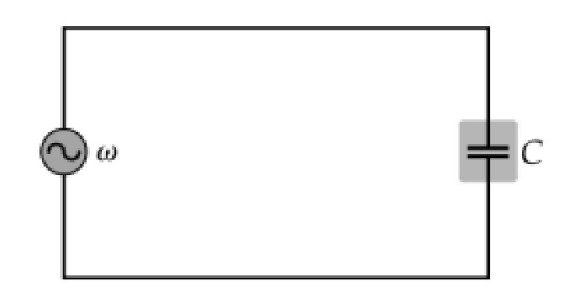
-
It decreases by a factor of 2
-
It increases by a factor of 2
-
It increases by a factor of 4
-
It decreases by a factor of 4
-
No correct answer
-
An electron moves in the plane of this paper toward the top of the page. A magnetic field is also in the plane of the page and directed toward the right. The direction of the magnetic force on the electron is
-
toward the left edge of the page
-
toward the right edge of the page
-
upward out of the page
-
downward into the page.
-
When there is no current in the wire, it remains vertical.
-
A wire suspended vertically between the poles of a magnet. The setup shown in the figure as seen looking at the south pole of the magnet, so that the magnetic field (blue crosses) is directed into the page.
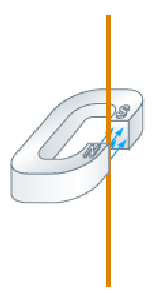 If
current is downward, show the suitable deflection of wire:
If
current is downward, show the suitable deflection of wire:
-
Not enough information to determine
-
None of them
-
Consider the current in the length of wire shown in figure. Where the magnetic field is greatest?

-
A
-
B
-
C
-
Everywhere is the same
-
Consider the magnitudes of
 for the closed paths in the figure.
for the closed paths in the figure.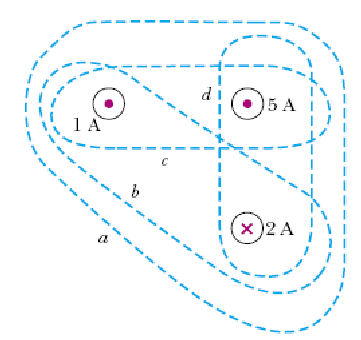 Where
the magnitude of
Where
the magnitude of
 is the greatest?
is the greatest?
-
a
-
b
-
c
-
d
-
a and b
-
What charge is located in the figure?

-
Negative
-
Positive
-
Uncharged
-
Positive and negative
-
Not possible to determine
-
Show the unit of electric field (E) in SI system?
-
C
-
V
-
V/m
-
C/m3
-
C/m2
-
Show the unit of electric potential in SI system?
-
C
-
V
-
V/m
-
C/m2
-
C/m3
-
If charge is increased by factor of 2, how does its electric potential change?
-
Increases 2 times
-
Decreases 2 times
-
Does not change
-
Increases 4 times
-
Decreases 4 times



